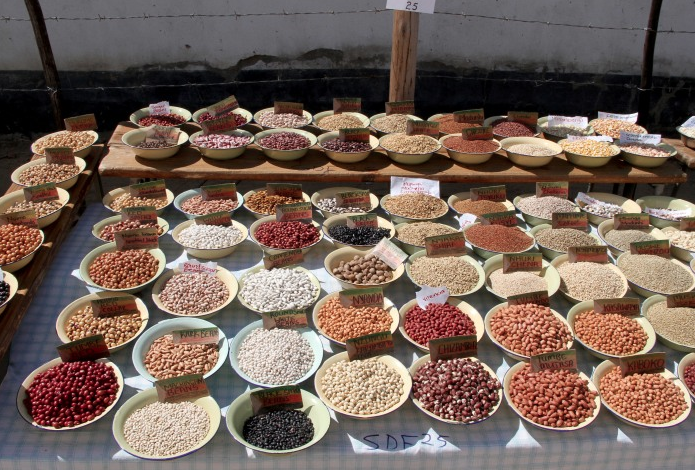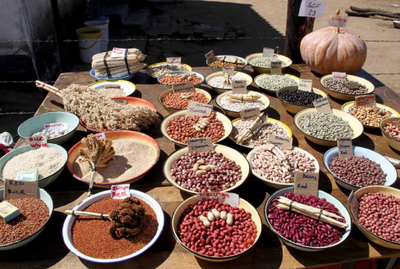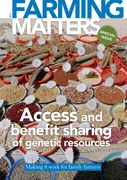What is successful access and benefit sharing for smallholder family farmers? This contribution argues it is not about legal contracts or mechanisms that regulate their international transfer of plant genetic resources. It is about farmers’ access to seed diversity and their ability to share in the benefits of the continuing cycles of seed conservation and development. The Community Technology Development Trust in Zimbabwe supports mechanisms that, in practice, do result in substantial access to and benefit sharing of local and modern varieties.

Successful access and benefit sharing (ABS) agreements under the Convention on Biological Diversity (CBD) and the Nagoya Protocol are a rarity and very few funds have flowed into the benefit sharing fund of the Treaty so far. Legal contracts that have been carefully drafted and negotiated by experienced lawyers seem to have become the heart of ABS implementation. In the face of these complex legal and technical challenges, the position and views of smallholder family farmers and indigenous communities can get easily overlooked. This is one of the main obstacles that these stakeholders face in respect to the current ABS systems.
As explained under the Nagoya Protocol and the CBD, the rights of (smallholder) farmers and indigenous communities are generally subordinated to those of the state. This is equally true for Farmers’ Rights as addressed by the Treaty. For example, while recognising that the right to save, use, exchange and sell farm-saved seed are fundamental to the realisation of Farmers’ Rights,1 the Treaty makes the actual protection of these rights subject to national legislation. As a consequence, they are easily subordinated to the interests and rights of breeders vested in national patent and plant variety protection legislation.2 It therefore may be useful to approach the issue of ABS the other way around. What could successful ABS imply for smallholder family farmers in, for example, Zimbabwe?
Access to seed diversity and quality seeds of their preferred varieties is absolutely crucial for family farmers
One of the key characteristics of family farmers is their direct involvement in various seed systems. Generally, smallholder farmers grow multiple crops sourced from different providers. For example, a farmer may receive seed as a contract grower for a cash crop such as tobacco, buy maize seed from a local seed trader, barter millet seed with a neighbouring farmer, buy tomato seed directly from a multinational seed company, and use farm saved planting materials for growing cassava. By doing so, family farmers aim to satisfy their various needs, such as income generation, food security, diet and the spreading of risks. Taking the importance of these various seed systems into account, it is clear that access to seed diversity, and more specifically, to quality seeds of their preferred varieties, is absolutely crucial for family farmers. Following this line of reasoning, we can identify alternative ABS mechanisms that are of particular interest to family farmers – i.e. mechanisms that promote the availability and accessibility of quality seeds for both traditional and modern varieties.
Facilitating access to local varieties

Community seed banks can be seen as an institutional platform for making decisions about crop cultivation, seed production and conservation of locally adaptive germplasm. Photo: Patrick Kasasa
Considering family farmers’ need to access quality seeds of local and traditional varieties, two initiatives that can function as alternative ABS mechanisms are community seed banks and seed fairs. The Community Technology Development Trust (CTDT) organises over 20 seed fairs which facilitate seed and knowledge exchanges in Zimbabwe every year, as well as supporting three community seed banks which are located in marginal regions of the country.The community seed banks were established in the early 1990s as a response to droughts that were ravaging the country. They sought to prevent further losses to farmers’ plant genetic resources, prevent geneticerosion, act as a risk aversion measure against the effects of climate change and vulnerability, and conserve local crop varieties on-farm. Over the years, the community seed banks helped farmers to enhance cultivation of local, drought tolerant crops, including sorghum, pearl millet, groundnuts, cowpeas and local vegetables.
Community seed banks can be seen as a collective framework and institutional platform for making decisions about crop cultivation, seed production and conservation of locally adaptive germplasm. As such, they are an effective mechanism to implement farmers’ rights as defined by the Treaty.
Women are key actors in seed bank activities and make up at least half of the management committee
Any member of the community can ask for seed from the general collections category for purposes of multiplication. When the farmer has multiplied the seed, he or she returns at least 5 kg to the seed bank. The seed is further distributed to other farmers. Members of a household can freely withdraw from the seed bank small quantities of seed they want at any time. However, drawing seed from the seed bank is usually done at the beginning of the season. Farmers share and exchange seed freely. Members of a farmer field school also use materials from the seed bank in their study plots (demo or diversity plots).
Women, who play a key role in household food security, participate in seed bank activities and make up at least half of the 12-member management committee. Because of socioeconomic and cultural norms and values, women are the main actors within the smallholder agricultural sector in Zimbabwe and, thus, are the main contributors to selecting seeds in the field and after harvest, cleaning and depositing seeds, participating in seed fairs and the general upkeep of the building. Anyone from outside the community can access materials from the seed bank at a cost. If the person wants seed from the family collections, they are directed to the owner (household) and the two parties then agree on transaction terms. But if the person (farmers, breeders, researchers, visitors, etc.) is interested in material from the general collections category, the seed bank committee negotiates on behalf of the community for payment.
Seed in the general storage room belongs to individual members and are used by them free of charge. This seed acts as a seed reserve in case of drought, flood or any other catastrophe. The seed in the bulk storage room is sold to anyone who wants seed. However, nonmembers, especially the most vulnerable such as elders and orphans, may also be given seeds on the recommendation of the management committee – a social commitment made by the seed bank.
Technical support is available as well. In Tsholotsho, for example, the International Crops Research Institute for the Semi-Arid Tropics (ICRISAT) trained CTDT staff and Zimbabwe’s agricultural extension service (AGRITEX) officers in crop improvement. The national gene bank also trains the same officers in germplasm collection, recording, processing and storage. AGRITEX is always on the ground working closely with seed bank management committees. CTDT provides technical back stopping to both field officers and the committees. CTDT has also trained all committee members in leadership and seed bank management. Exchange visits (look-and-learn tours) have been organised to allow committee members to share information and ideas, including best practices for plant genetic resource management.
The crucial role of seed fairs

Seed fairs are held annually at each community seed bank and biannually at the national level. Initially organised by CTDT in collaboration with the farmers’ management committees, these events are now planned by the community seed bank committees. During seed fairs, farmers are encouraged to display their crops, and prizes are awarded based on the number and range of crops on display, seed quality and presentation. The seed fairs provide a forum for farmers to meet, discuss and exchange seeds, knowledge and their experience with old and new crops and to exchange information about local level seed production. Seed fairs also make it possible to evaluate the level of diversity within the community and assess and monitor genetic erosion. Seeds are also acquired at the fairs to increase seed bank collections.
The seed banks are successful due to the fact that they are community driven and managed, maintain agricultural biodiversity that is adapted to their local ecological environment, and ensure easy access and benefit sharing for smallholder farmers in terms of seeds of choice. The element of ownership and control of smallholder farmer preferred seeds is a key component that provides options, choices and alternatives. Farmers have the opportunity to practice onfarm, pre-harvest seed selection in their cereal crops, the ability to use a complex selection criteria based on use of the crop, and engage in varietal selection and subsequent use of the seed. Other advantages are the timely availability of seed from the community seed bank, storage of strategic seed reserves at community level, the exchange of seed, and local knowledge systems and experience. These complementary components contribute to the community seed security, which is important in ensuring food and nutrition security. Lastly, preservation of biocultural practices associated with the crops is important as well.
Family farmer control is a key component of community seed banks that provides options, choices and alternatives
Nonetheless, there is the need to compliment these efforts with adequate documentation and development of a better, updated database of the germplasms stored in these community seed banks. Capacity building allows farmers to engage in participatory plant breeding and variety selection (PPB/PVS), which improves crops. The other element is on-farm characterisation of farmer varieties and information sharing so.
There are a number of lessons that can be drawn from community seed banking practices. These lessons include a better understanding of the local seed systems, opportunities to build on famer seed systems and creating mechanisms to support and strengthen community based seed systems, the ability of farmers to maintain local agricultural biodiversity on-farm, conservation and sustainable use of local agricultural biodiversity, the development of community strategic seed reserves, the maintenance of bio-cultural practices related to local genetic resources, access and benefit sharing to the seed of choice, knowledge sharing, and community seed exchange designed to improve farmer’s seed supply systems.
Facilitating access to modern varieties
It is clear that family farmers grow multiple crops that are accessed through various seed systems. These include ‘modern’ varieties coming from either the public or private breeding sector, as we have seen above. Amongst the perceived benefits of such varieties are higher yields and marketability. Yet it also is clear that smallholders have few resources and cannot afford to buy seed each cropping season. The relatively expensive seed of modern varieties, plus the additional inputs required by these modern varieties, put smallholders at risk since their budgets for farming supplies compete directly with basic needs such as health care and education.3 For that reason, smallholders try to access modern varieties mainly through the same practices of exchanging and trading farm-saved seed.4 Unfortunately, it is exactly these farming practices that are rendered illegal once a modern variety is protected under a plant breeder’s right.
Looking at the controversies surrounding ABS this is clearly one of the main problems in the current international legal framework governing seeds and plant genetic material. Farmers’ varieties are freely accessible for all without any perceivable benefit sharing mechanism attached, whereas modern varieties come with a price plus restrictions on their further use. This unequal situation is also the source of resistance against the ongoing harmonisation of plant variety protection (PVP) in Africa. Zimbabwe is a member to two regional organisations that are involved in this process: the African Regional Intellectual Property Organisations (ARIPO), which has recently adopted the Arusha Protocol for the Protection of New Varieties of Plants, and the Southern African Development Community (SADC) that is in the process of doing the same. Both organisations aim to implement a plant variety protection system in the region that awards exclusive rights to produce, reproduce or offer for sale a protected variety to the person who bred, or discovered and developed, a new variety eligible for protection.In their current form, both regional PVP systems strongly curtail the farming practices of family farmers with respect to protected varieties. (5) However, both legal frameworks include the ‘private and non-commercial use’ exemption. This means that private use of a protected variety for non-commercial purposes is allowed. As a consequence, the use, exchange and local trade of protected varieties amongst smallholders as practiced in community seed banks can be considered to fall within the scope of this exemption. Such use is essentially for subsistence purposes and hardly, if at all, affects the commercial interests of the breeder. (6) By explicitly confirming this in their implementation regulations, the ARIPO and SADC countries can make their PVP legislation supportive of one important benefit sharing component – the benefits of genetic resource utilization by the formal breeding sector are accessible (i.e., delivered back) to smallholder family farmers.
‘Alternative’ ABS mechanisms
Other mechanisms that can strongly improve the availability of quality seed for family farmers are seed repatriation from national gene banks and participatory plant breeding. Together with community seeds banks and seed fairs, these types of mechanism that can effectively improve the availability and accessibility of quality seed of the varieties most preferred by farmers. That is what successful ABS implies for smallholder family farmers. It is about accessing and sharing the benefits of seed diversity. This is most crucial for family farmers, which are both the predominant users and providers of seed for most food crops in many parts of the world.
Whereas policymakers and negotiators are mainly discussing ABS mechanisms that regulate the international transfer of genetic resources, we recommend to shift the focus from provider countries and user companies to family farmers. Mechanisms that facilitate the availability and sharing of seed diversity amongst farmers then become the heart of successful ABS implementation. It is these mechanisms – and not legal contracts – that give meaning and purpose to ABS for smallholder family farmers.
Notes
1 ITPGRFA, Preamble.
2 Lawson, Charles. (2015). Implementing farmer’s rights : finding meaning and purpose for the international treaty on plant genetic resources for food and agriculture commitments? European intellectual property review 37(7), pp. 442-454.
3 Berne Declaration (et al.). (2014). Owning Seed, Accessing Food: A Human Rights Impact Assessment of UPOV 1991 Based on Case Studies in Kenya, Peru and the Philippines. Zurich, Switzerland: Berne Declaration.
4 Louwaars, N.P., & De Boef, W.S. (2012). Integrated seed sector development in Africa: A conceptual framework for creating coherence between practices, programs, and policies. Journal of Crop Improvement, 26, pp. 39–59.
5 De Jonge, B. (2014). Plant Variety Protection in Sub-Saharan Africa: Balancing Commercial and Smallholder Farmers’ Interests. Journal of Politics and Law 7(3), pp. 100-111.
6 De Jonge, B., Munyi, P. (2016). A Differentiated Approach to Plant Variety Protection in Africa. Journal of World Intellectual Property.
Bram De Jonge (bram.dejonge@wur.nl) is a researcher at Wageningen University. His research is funded by the Netherlands Organisation for Scientific Research (NWO) as part of the research programme Responsible Innovation.
Andrew Mushita (andrew@ctdt.co.zw) is the Director of the Community Technology Development Trust in Harare, Zimbabwe and Patrick Kasasa (patrick@ctdt.co.zw) is its Biodiversity Programme Coordinator.

